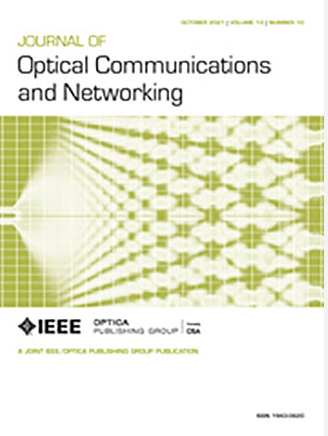101.6 km空心光纤中量子密钥分配与大功率经典通信共存的实验研究
IF 4.3
2区 计算机科学
Q1 COMPUTER SCIENCE, HARDWARE & ARCHITECTURE
引用次数: 0
摘要
量子密钥分配(QKD)与经典光网络的集成已成为构建安全通信基础设施的关键策略。然而,在硅芯光纤中实现它们的共存面临着非线性干扰的固有限制,特别是在高经典信号功率下。在本文中,据我们所知,我们首次通过实验证明了经典光传输网络和QKD在101.6 km的经典功率超过20 dBm的空心芯光纤(HCF)上共存。通过系统的理论分析,表征了HCF的传输损耗和非线性噪声产生机制,揭示了与传统光纤相比,HCF具有高功率经典量子共存的独特兼容性。为了解决HCF吸收峰的频谱干扰和非线性效应,提出了一种协调低损耗信道选择和噪声抑制的频谱优化多级分配(SOMA)方案。实验验证表明,在SOMA方案下,共存的经典信号在单波长配置下达到19 dBm,在多波长配置下达到21 dBm,同时保持10 kbps以上的安全密钥速率。这一突破使HCF成为同时实现高容量经典通信和量子安全数据传输的可行平台,克服了现有基于光纤的共存系统的关键功率限制。本文章由计算机程序翻译,如有差异,请以英文原文为准。
Experimental coexistence of quantum key distribution and high-power classical communication over 101.6 km hollow-core fiber
The integration of quantum key distribution (QKD) with classical optical networks has emerged as a pivotal strategy for building secure communication infrastructures. However, achieving their coexistence in silica-core fibers faces inherent limitations due to nonlinear interference, particularly under high classical signal power. In this paper, we experimentally demonstrate the coexistence of classical optical transport networks and QKD over 101.6 km of hollow-core fiber (HCF) with classical power exceeding 20 dBm for the first time to the best of our knowledge. Through systematic theoretical analysis, we characterize HCF’s transmission loss and nonlinear noise generation mechanisms, revealing its unique compatibility with high-power classical–quantum coexistence compared to conventional fibers. To address spectral interference from HCF’s absorption peaks and nonlinear effects, we propose a spectrally optimized multi-stage allocation (SOMA) scheme that coordinates low-loss channel selection and noise suppression. Experimental validation shows that, under the SOMA scheme, coexisting classical signals achieve 19 dBm in single-wavelength configuration and 21 dBm in multi-wavelength configuration, while maintaining a secure key rate above 10 kbps. This breakthrough establishes HCF as a viable platform for simultaneous high-capacity classical communication and quantum-secured data transmission, overcoming critical power limitations of existing fiber-based coexistence systems.
求助全文
通过发布文献求助,成功后即可免费获取论文全文。
去求助
来源期刊
CiteScore
9.40
自引率
16.00%
发文量
104
审稿时长
4 months
期刊介绍:
The scope of the Journal includes advances in the state-of-the-art of optical networking science, technology, and engineering. Both theoretical contributions (including new techniques, concepts, analyses, and economic studies) and practical contributions (including optical networking experiments, prototypes, and new applications) are encouraged. Subareas of interest include the architecture and design of optical networks, optical network survivability and security, software-defined optical networking, elastic optical networks, data and control plane advances, network management related innovation, and optical access networks. Enabling technologies and their applications are suitable topics only if the results are shown to directly impact optical networking beyond simple point-to-point networks.

 求助内容:
求助内容: 应助结果提醒方式:
应助结果提醒方式:


